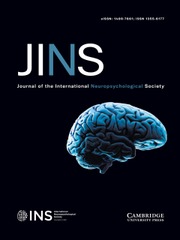Crossref Citations
This article has been cited by the following publications. This list is generated based on data provided by
Crossref.
Patterson, Janet P.
2017.
Encyclopedia of Clinical Neuropsychology.
p.
1.
Feenstra, Heleen EM
Vermeulen, Ivar E
Murre, Jaap MJ
and
Schagen, Sanne B
2018.
Online Self-Administered Cognitive Testing Using the Amsterdam Cognition Scan: Establishing Psychometric Properties and Normative Data.
Journal of Medical Internet Research,
Vol. 20,
Issue. 5,
p.
e192.
Díaz-Orueta, Unai
Blanco-Campal, Alberto
and
Burke, Teresa
2018.
Rapid review of cognitive screening instruments in MCI: proposal for a process-based approach modification of overlapping tasks in select widely used instruments.
International Psychogeriatrics,
Vol. 30,
Issue. 5,
p.
663.
Gordon, Jean K.
Young, Megan
and
Garcia, Carly
2018.
Why do older adults have difficulty with semantic fluency?.
Aging, Neuropsychology, and Cognition,
Vol. 25,
Issue. 6,
p.
803.
Patterson, Janet P.
2018.
Encyclopedia of Clinical Neuropsychology.
p.
1403.
Vaughan, Roisin M.
Coen, Robert F.
Kenny, RoseAnne
and
Lawlor, Brian A.
2018.
Semantic and Phonemic Verbal Fluency Discrepancy in Mild Cognitive Impairment: Potential Predictor of Progression to Alzheimer's Disease.
Journal of the American Geriatrics Society,
Vol. 66,
Issue. 4,
p.
755.
Abbott, Rosemary A.
Skirrow, Caroline
Jokisch, Martha
Timmers, Maarten
Streffer, Johannes
van Nueten, Luc
Krams, Michael
Winkler, Angela
Pundt, Noreen
Nathan, Pradeep J.
Rock, Philippa
Cormack, Francesca K.
and
Weimar, Christian
2019.
Normative data from linear and nonlinear quantile regression in CANTAB: Cognition in mid‐to‐late life in an epidemiological sample.
Alzheimer's & Dementia: Diagnosis, Assessment & Disease Monitoring,
Vol. 11,
Issue. 1,
p.
36.
McCullough, Kim C.
Bayles, Kathryn A.
and
Bouldin, Erin D.
2019.
Language Performance of Individuals at Risk for Mild Cognitive Impairment.
Journal of Speech, Language, and Hearing Research,
Vol. 62,
Issue. 3,
p.
706.
Vogel, Asmus
Stokholm, Jette
and
Jørgensen, Kasper
2020.
Normative data for eight verbal fluency measures in older Danish adults.
Aging, Neuropsychology, and Cognition,
Vol. 27,
Issue. 1,
p.
114.
Vonk, Jet M. J.
Bouteloup, Vincent
Mangin, Jean‐François
Dubois, Bruno
Blanc, Frédéric
Gabelle, Audrey
Ceccaldi, Mathieu
Annweiler, Cédric
Krolak‐Salmon, Pierre
Belin, Catherine
Rivasseau‐Jonveaux, Thérèse
Julian, Adrien
Sellal, François
Magnin, Eloi
Chupin, Marie
Habert, Marie‐Odile
Chêne, Geneviève
and
Dufouil, Carole
2020.
Semantic loss marks early Alzheimer's disease‐related neurodegeneration in older adults without dementia.
Alzheimer's & Dementia: Diagnosis, Assessment & Disease Monitoring,
Vol. 12,
Issue. 1,
Peeters, Geeske
Romero-Ortuno, Roman
Lawlor, Brian
Kenny, Rose Anne
and
McHugh Power, Joanna
2020.
Clustering of Behavioral Changes and Their Associations With Cognitive Decline in Older Adults.
Journal of the American Medical Directors Association,
Vol. 21,
Issue. 11,
p.
1689.
Chasles, M -J
Tremblay, A
Escudier, F
Lajeunesse, A
Benoit, S
Langlois, R
Joubert, S
and
Rouleau, I
2020.
An Examination of Semantic Impairment in Amnestic MCI and AD: What Can We Learn From Verbal Fluency?.
Archives of Clinical Neuropsychology,
Vol. 35,
Issue. 1,
p.
22.
Saredakis, Dimitrios
Keage, Hannah AD
Corlis, Megan
and
Loetscher, Tobias
2020.
Using Virtual Reality to Improve Apathy in Residential Aged Care: Mixed Methods Study.
Journal of Medical Internet Research,
Vol. 22,
Issue. 6,
p.
e17632.
Devora, Paulina V
Beevers, Samantha
Kiselica, Andrew M
and
Benge, Jared F
2020.
Normative Data for Derived Measures and Discrepancy Scores for the Uniform Data Set 3.0 Neuropsychological Battery.
Archives of Clinical Neuropsychology,
Vol. 35,
Issue. 1,
p.
75.
Diaz-Orueta, Unai
Blanco-Campal, Alberto
Lamar, Melissa
Libon, David J.
and
Burke, Teresa
2020.
Marrying Past and Present Neuropsychology: Is the Future of the Process-Based Approach Technology-Based?.
Frontiers in Psychology,
Vol. 11,
Issue. ,
Loughrey, David G.
Pakhomov, Serguei V.S.
and
Lawlor, Brian A.
2020.
Altered verbal fluency processes in older adults with age-related hearing loss.
Experimental Gerontology,
Vol. 130,
Issue. ,
p.
110794.
Petkus, Andrew J.
Younan, Diana
Wang, Xinhui
Beavers, Daniel P.
Espeland, Mark A.
Gatz, Margaret
Gruenewald, Tara
Kaufman, Joel D.
Chui, Helena C.
Millstein, Joshua
Rapp, Stephen R.
Manson, JoAnn E.
Resnick, Susan M.
Wellenius, Gregory A.
Whitsel, Eric A.
Widaman, Keith
Chen, Jiu-Chiuan
and
Zammit, Andrea
2021.
Associations Between Air Pollution Exposure and Empirically Derived Profiles of Cognitive Performance in Older Women.
Journal of Alzheimer's Disease,
Vol. 84,
Issue. 4,
p.
1691.
Blanco-Campal, Alberto
Diaz-Orueta, Unai
Navarro-Prados, Ana Belen
Burke, Teresa
Libon, David J.
and
Lamar, Melissa
2021.
Features and psychometric properties of the Montreal Cognitive Assessment: Review and proposal of a process-based approach version (MoCA-PA).
Applied Neuropsychology: Adult,
Vol. 28,
Issue. 6,
p.
658.
Muayqil, Taim A.
Alshathri, Reem M.
Alnasser, Hebah A.
Alfawzan, Lama A.
AlQarni, Amal A.
Alkeridy, Walid A.
Nafisah, Ibrahim
Aljafen, Bandar N.
and
Alanazy, Mohammed H.
2021.
Effects of age, sex and education on verbal fluency tasks in a normal Saudi sample.
Journal of Clinical and Experimental Neuropsychology,
Vol. 43,
Issue. 9,
p.
879.
Loughrey, David G
Mihelj, Ernest
and
Lawlor, Brian A
2021.
Age-related hearing loss associated with altered response efficiency and variability on a visual sustained attention task.
Aging, Neuropsychology, and Cognition,
Vol. 28,
Issue. 1,
p.
1.




